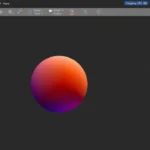Choosing a diamond can feel like navigating a dazzling maze. You’re bombarded with terms like carat, cut, color, and clarity, and then suddenly, you see a string of numbers like 8.17×5.64×3.52. What does it all mean? If you’re eyeing a diamond with these precise dimensions, whether for a breathtaking engagement ring, a valuable addition to your jewelry collection, or simply as a luxurious indulgence, you’ve come to the right place.
This guide is your essential roadmap to understanding the significance of an 8.17×5.64×3.52 diamond, cutting through the jargon to give you the knowledge you need to make a confident and informed decision. We’ll delve beyond the standard 4Cs to explore how these specific measurements impact the diamond’s beauty, size, and overall value. Forget generic diamond advice – we’re getting granular, focusing specifically on the fascinating world revealed by these three numbers.
Whether you’re dreaming of a romantic oval diamond, a sophisticated pear shape, or a bold marquise cut, understanding dimensions is paramount. Let’s unlock the secrets hidden within 8.17×5.64×3.52 and discover if this diamond is your perfect match.
Table of Contents
Decoding the Dimensions: What 8.17×5.64×3.52 Really Tells You
Those three numbers aren’t random. They represent the dimensions of the diamond in millimeters (mm): Length x Width x Depth. For our 8.17×5.64×3.52 diamond, we’re looking at:
- 8.17mm Length: The longest point-to-point measurement of the diamond.
- 5.64mm Width: The measurement across the widest part of the diamond, perpendicular to the length.
- 3.52mm Depth: The height of the diamond from the table (the top, flat facet) to the culet (the pointed bottom, if present).
These dimensions immediately tell us a crucial piece of information: this diamond is not round. Round brilliant diamonds are typically described by diameter and depth, not length and width. The length and width measurements indicate we are dealing with a fancy shaped diamond, most likely an oval, pear, or marquise, all popular choices for engagement rings and statement jewelry.
But why are these numbers so important? It all boils down to how they affect the diamond’s appearance and light performance.
Size Matters: Dimensions and Face-Up Area
While carat weight is often the first thing people ask about when it comes to diamonds, dimensions are actually more directly related to perceived size. Carat is a unit of weight, but dimensions dictate how large the diamond looks when set in jewelry and viewed from above – what jewelers call the face-up size.
Think of it like this: two diamonds can have the same carat weight but vastly different dimensions. A diamond that is cut too deep might carry a lot of its weight in the depth, appearing smaller face-up than a diamond with more spread. Conversely, a diamond that is cut too shallow might look larger but sacrifice brilliance and fire.
An 8.17×5.64 diamond indicates a significant face-up area. To put this into perspective, consider a simplified diamond size chart:
| Diamond Shape | Carat Weight (Approximate) | Typical Length (mm) | Typical Width (mm) |
|---|---|---|---|
| Round Brilliant | 1.00 ct | 6.5 mm Diameter | 6.5 mm Diameter |
| Oval | 1.00 ct | 7.5 mm | 5.5 mm |
| Pear | 1.00 ct | 8.0 mm | 5.0 mm |
| Marquise | 1.00 ct | 9.5 mm | 4.5 mm |
Note: These are approximate figures and can vary based on cut proportions. This table is for illustrative purposes only.
Looking at this, an 8.17mm length suggests a diamond potentially larger than a typical 1-carat oval or pear shape. Combined with a 5.64mm width, we are likely in the territory of a diamond that offers a visually impressive presence on the finger. For those seeking a diamond that looks substantial and makes a statement, the dimensions 8.17×5.64 are a promising starting point.
Key Takeaway: Dimensions directly impact how large a diamond appears. 8.17×5.64 suggests a visibly sizable diamond, particularly in elongated shapes like oval, pear, or marquise.
The Golden Ratio: Understanding Length-to-Width Ratio
For fancy shaped diamonds like ovals, pears, and marquises, the length-to-width ratio is a crucial factor in aesthetics. This ratio is calculated by dividing the length by the width (Length / Width). For our 8.17×5.64 diamond, the length-to-width ratio is approximately:
8.17 / 5.64 = ~ 1.45
So, what does a 1.45 ratio tell us? It dictates the overall shape’s elegance and balance. Ideal length-to-width ratios vary slightly depending on personal preference and the specific shape, but here’s a general guideline for popular elongated fancy shapes:
- Oval: Ideal ratio typically ranges from 1.30 to 1.50. A ratio of 1.45 falls squarely within this sweet spot, suggesting a beautifully balanced oval shape – not too round, not too elongated.
- Pear: Ideal ratio is generally between 1.40 to 1.70. Again, 1.45 is a good starting point, leaning towards a slightly wider pear shape. Some prefer a more elongated pear (closer to 1.6-1.7), while others prefer a rounder one (closer to 1.4).
- Marquise: Marquise shapes tend to be more elongated, with ideal ratios ranging from 1.75 to 2.25. A 1.45 ratio would be considered quite wide for a marquise, potentially appearing less traditionally “marquise” shaped and perhaps more like a rounded oval.
Comparison Table: Ideal Length-to-Width Ratios
| Diamond Shape | Ideal Length-to-Width Ratio Range | 8.17×5.64 Ratio (1.45) |
|---|---|---|
| Oval | 1.30 – 1.50 | Excellent Fit |
| Pear | 1.40 – 1.70 | Good Fit, Wider Style |
| Marquise | 1.75 – 2.25 | Wider than Typical |
Important Note: Ratios are guidelines, not rigid rules. Ultimately, the “best” ratio is subjective and comes down to personal taste. Some people prefer a rounder oval, while others love a more slender, elongated look. However, sticking within the ideal ranges generally ensures a visually pleasing and well-proportioned diamond.
Key Takeaway: The length-to-width ratio of 1.45 for an 8.17×5.64 diamond is ideal for an oval, a good starting point for a wider pear, but potentially too wide for a traditional marquise.
Beyond Length and Width: The Importance of Depth (3.52mm)
While length and width primarily dictate face-up size and shape, the depth (3.52mm) plays a critical role in light performance. Depth percentage, calculated as (Depth / Width) x 100, is a key factor in how well a diamond reflects light.
For fancy shapes, ideal depth percentages can vary slightly, but generally, you want to aim for a depth percentage that allows for optimal light return. If a diamond is cut too deep, light can escape through the bottom instead of reflecting back to your eye, resulting in a less brilliant diamond. Conversely, if it’s cut too shallow, light can escape from the sides, also diminishing brilliance.
For an 8.17×5.64×3.52 diamond, the depth percentage is:
(3.52 / 5.64) x 100 = ~ 62.4%
Generally, for oval, pear, and marquise shapes, a depth percentage in the range of 58% to 64% is considered quite good. Our 62.4% depth percentage falls right within this favorable zone, suggesting that this diamond has a good chance of exhibiting strong brilliance and light return.
However, depth percentage is just one piece of the puzzle. Other depth-related factors like pavilion depth percentage and crown angle also contribute to the overall cut quality. This is where certification from reputable gemological labs like GIA (Gemological Institute of America) or AGS (American Gem Society) becomes absolutely crucial.
Key Takeaway: A depth of 3.52mm, resulting in a ~62.4% depth percentage for an 8.17×5.64 diamond, is generally within the ideal range for light performance in fancy shapes. However, always prioritize a GIA or AGS certification to assess the overall cut quality and light performance comprehensively.
The Bow-Tie Effect: A Consideration for Elongated Shapes
One important optical phenomenon to be aware of in elongated fancy shaped diamonds like ovals, pears, and marquises is the bow-tie effect. This refers to a dark area that can appear in the center of the diamond, resembling a bow-tie shape.
The bow-tie effect is caused by light obstruction due to the diamond’s facet arrangement underneath the table. It’s inherent to these shapes to some degree, and almost all elongated diamonds will exhibit some level of bow-tie.
However, the severity of the bow-tie is what matters. A slight bow-tie can actually add character and depth to the diamond, while a strong, dark bow-tie can be distracting and detract from brilliance.
Dimensions and proportions influence the bow-tie effect. While we can’t definitively determine the bow-tie from just the 8.17×5.64×3.52 dimensions alone, the length-to-width ratio and depth play a role. Diamonds with less ideal cut proportions may exhibit a more pronounced bow-tie.
How to assess the bow-tie:
- Visual Inspection: The best way is to see the diamond in person or view high-resolution videos from multiple angles under different lighting conditions. Reputable online retailers like Blue Nile and James Allen often provide these resources.
- Certification Reports: While GIA and AGS reports don’t explicitly grade the bow-tie effect, they do grade cut quality and proportions, which indirectly relate to it. An “Excellent” or “Ideal” cut grade from AGS or a high cut grade from GIA generally suggests better light performance and potentially less problematic bow-tie.
- Expert Consultation: Don’t hesitate to consult with a knowledgeable jeweler. They can assess the diamond and advise you on the bow-tie effect and its impact on the diamond’s beauty.
Key Takeaway: The bow-tie effect is a common consideration for elongated fancy shapes. While dimensions offer clues, visual inspection and expert advice are crucial for assessing its severity.
Ideal Proportions: It’s a Symphony, Not Just Solo Numbers
While we’ve broken down length, width, depth, and ratio, remember that ideal diamond proportions are about the harmony of all these factors together, not just hitting specific numbers in isolation. It’s akin to a symphony – all the instruments (proportions) need to play in tune (ideal ranges) to create beautiful music (optimal light performance).
“Best diamond proportions” aren’t a rigid formula. They are guidelines that maximize brilliance, fire, and scintillation. For an 8.17×5.64×3.52 diamond, we’ve seen that the dimensions are promising for an oval, pear, or wider marquise shape, with a favorable depth percentage.
However, to truly determine if these are “best” proportions for this specific diamond, you need to consider the complete picture provided by a GIA or AGS grading report. This report will delve into:
- Cut Grade: Overall assessment of how well the diamond is cut (GIA grades cut for round diamonds, AGS provides cut grades for rounds and fancy shapes).
- Polish and Symmetry: Crucial for light performance. Aim for “Excellent” or “Very Good” polish and symmetry.
- Table Percentage: The size of the table facet relative to the diamond’s width.
- Crown Angle and Pavilion Depth Percentage: These angles significantly impact light reflection and brilliance.
Recommendation: Always prioritize a diamond with a GIA or AGS certification. These reports provide objective, expert assessments of cut quality and proportions, far beyond just dimensions. Think of the 8.17×5.64×3.52 dimensions as a starting point, and the certification report as the detailed blueprint that reveals the true potential of the diamond.
Key Takeaway: Dimensions are important, but “best diamond proportions” are a holistic concept. Always rely on GIA or AGS certification reports for a comprehensive assessment of cut quality and light performance.
Buying Considerations for an 8.17×5.64×3.52 Diamond
If you’re captivated by the idea of an 8.17×5.64×3.52 diamond, here are crucial buying considerations:
- Shape Preference: Decide if you prefer an oval, pear, or wider marquise shape. The 1.45 ratio is most naturally suited to an oval.
- Certification is Non-Negotiable: Insist on a GIA or AGS certificate. Verify the certificate number online on the respective lab’s website.
- Cut Quality is Key: Analyze the cut details on the certificate. Aim for high cut grades, excellent polish, and excellent symmetry.
- Assess the Bow-Tie: If possible, view the diamond directly or through high-quality videos. Evaluate the severity of any bow-tie.
- Consider Color and Clarity: Choose color and clarity grades that align with your budget and personal preferences. For larger diamonds, you might be more discerning about these factors.
- Compare Prices: Shop around at reputable retailers like Blue Nile, James Allen, and local jewelers. Compare prices for diamonds with similar specifications.
- Read Reviews and Reputation: Choose a retailer with a strong reputation for ethical sourcing and customer service.
- Trust Your Eye: Ultimately, choose a diamond that you find beautiful and that resonates with you. Dimensions and certifications provide valuable data, but your personal aesthetic preference is paramount.
Why an 8.17×5.64×3.52 Diamond Could Be Your Perfect Choice
An 8.17×5.64×3.52 diamond offers the potential for:
- Impressive Visual Size: The dimensions indicate a diamond with a significant face-up area, appearing larger than many diamonds of the same carat weight.
- Elegant Elongated Shape: Perfect for lovers of oval, pear, or wider marquise shapes, offering a sophisticated and flattering look on the finger.
- Balanced Proportions (especially for ovals): The length-to-width ratio of 1.45 is ideal for a classic oval shape.
- Potential for Excellent Light Performance: With a favorable depth percentage and good cut, this diamond has the potential to be brilliantly sparkly.
- Statement Piece Potential: A diamond of this size and dimension is sure to turn heads and become a cherished piece in any jewelry collection.
In Conclusion:
The numbers 8.17×5.64×3.52 unlock a world of understanding about a diamond. They tell a story of size, shape, and potential beauty. By understanding these dimensions in conjunction with other critical factors like length-to-width ratio, depth percentage, cut quality, and certification, you can confidently navigate the diamond buying process and find a truly exceptional gem. Whether you’re seeking the perfect engagement ring, a striking addition to your collection, or a luxurious treat for yourself, an 8.17×5.64×3.52 diamond, when carefully chosen, promises to be a dazzling and cherished treasure for years to come.
Frequently Asked Questions (FAQ) about 8.17×5.64×3.52 Diamonds
Q: What does 8.17×5.64×3.52 mean in diamond dimensions?
A: It represents the length, width, and depth of the diamond in millimeters (mm). 8.17mm is the length, 5.64mm is the width, and 3.52mm is the depth. This measurement indicates a fancy shaped diamond, likely oval, pear, or marquise.
Q: Is an 8.17×5.64 diamond a big diamond?
A: Yes, these dimensions suggest a visibly sizable diamond, especially for fancy shapes. It offers a substantial face-up area and will likely appear larger than a typical 1-carat oval or pear shape.
Q: What shape is best suited for 8.17×5.64×3.52 dimensions?
A: These dimensions are most ideally suited for an oval shape diamond due to the length-to-width ratio of approximately 1.45, which falls within the ideal range for ovals. It could also work for a wider style pear shape or a less traditional, wider marquise.
Q: What is a good length-to-width ratio for an oval diamond?
A: The ideal length-to-width ratio for an oval diamond is typically between 1.30 and 1.50. A ratio of 1.45 (like in our 8.17×5.64 diamond) is considered excellent.










